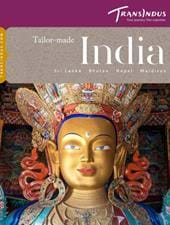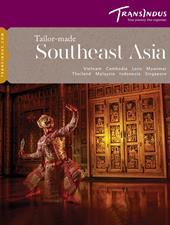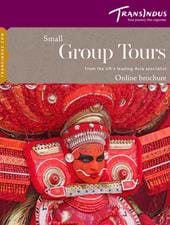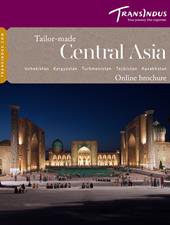The best time to visit India is generally between October and March when the weather is clear and sunny during the day and nights are mild, although this largely depends on where you are in India. It is a huge country, and the weather varies from region to region. Here, we break down the best times to travel by region to help you better plan your journeys.

The Taj Mahal in Agra is captivating year-round. Whether you visit during monsoon or the scorching summer, the architectural marvel never fails to impress. Early mornings are ideal for avoiding crowds and capturing the monument in the best light.
- Average Temperature: Daytime temperatures range from 20°C to 35°C (68°F to 95°F), with colder mornings in winter.
- Lowest Temperature: Around 5°C (41°F) early mornings in winter
- Highest Temperature: Up to 45°C (113°F) midday in summer.
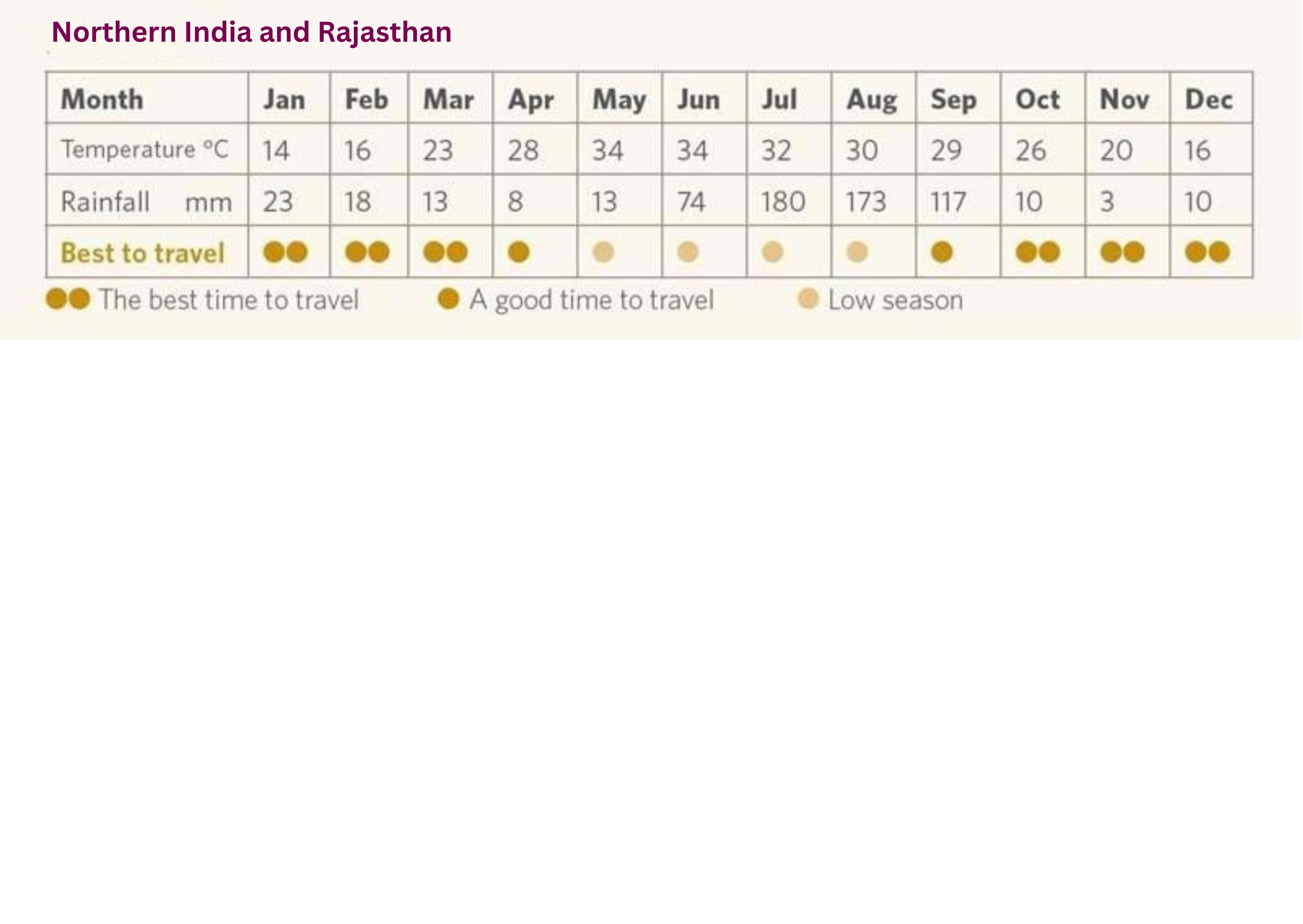

The prime time to explore northern India is generally from late October to March. The weather is cool, dry, and sunny during these months, making it ideal for sightseeing. However, December and January can be chilly, especially around Delhi and Amritsar in the Punjab, which can see significant fog in the early mornings and late evenings.
Wildlife Parks in the north normally open from November to May, except Ranthambore, which opens earlier in October.
- Summary: Northern India is Cool, dry, and sunny, with occasional chills in winter.
- Average Temperature: Daytime temperatures range from 14°C to 26°C (57°F to 79°F), with cooler nights.
- Lowest Temperature: Around 5°C (41°F) early mornings in January
- Highest Temperature: Up to 30°C (86°F) around midday in March.

Southern India boasts warm weather throughout the year, with varying levels of humidity and rainfall. The winter months from November to April are perfect for visiting places like Kerala and Tamil Nadu, where, incidentally, the wildlife parks remain open throughout the year. The monsoon season reaches the western coast between June and August, transforming the entire region into a lush green oasis. The east coast experiences a slightly later monsoon between mid-October and mid-November.
For those keen on swimming in the sea we recommend the three-month period of December to February.
- Summary: Warm throughout the year with varying humidity and rainfall.
- Average Temperature: Daytime temperatures range from 27°C to 30°C (77°F to 86°F), with warm nights.
- Lowest Temperature: Around 20°C (68°F) in winter
- Highest Temperature: Up to 32°C (90°F) in summer.

Central India's national parks, including those in Madhya Pradesh and Chhattisgarh, offer thrilling wildlife experiences. Visit between October and January for lush greenery or from March to pre-monsoon for the best wildlife sightings.
- Summary: Green post-monsoon, drier pre-monsoon, with hot summers.
- Average Temperature: Daytime temperatures range from 25°C to 35°C (77°F to 95°F), with much chilli mornings, especially in winter, so carry layers!
- Lowest Temperature: Around 10°C (50°F) in winter
- Highest Temperature: Up to 35°C (95°F) in summer

The best time to visit eastern India is typically from October to March when the weather is pleasant and dry. It is ideal for exploring destinations like Kolkata, Darjeeling, and the Sundarbans. Summers can be hot and humid, while the monsoon season brings heavy rainfall from June to September. The Kaziranga National Park is open from November to April.
- Summary: Pleasant and dry weather from October to March.
- Average Temperature: Daytime temperatures range from 25°C to 30°C (77°F to 86°F).
- Lowest Temperature: Around 15°C (59°F) in winter.
- Highest Temperature: Up to 35°C (95°F) in summer.
 Experience the majestic Himalayas between March and late November, when you have the best weather and clear skies, excluding July and August, when some regions see heavy rainfall. However, hill stations like Darjeeling, Shimla, and Mussoorie remain popular even in the summer as they offer respite from the heat of the lowlands.
Experience the majestic Himalayas between March and late November, when you have the best weather and clear skies, excluding July and August, when some regions see heavy rainfall. However, hill stations like Darjeeling, Shimla, and Mussoorie remain popular even in the summer as they offer respite from the heat of the lowlands.
Ladakh and Kashmir lie beyond the reach of the monsoon rains; here, the months of July and August, with their warm days and cool nights, are peak season.
- Summary: Scenic with pleasant temperatures and occasional showers.
- Average Temperature: Daytime temperatures range from 15°C to 25°C (59°F to 77°F), with colder nights and occasional showers.
- Lowest Temperature: Below freezing in winter, so be prepared with outerwear.
- Highest Temperature: Up to 25°C (77°F) in summer.

Western India is best visited from November to February. The cooler and drier weather is perfect for exploring destinations like Mumbai, Goa, and Rajasthan. Summers are scorching hot, while the monsoon season from June to September brings relief and heavy rainfall.
- Summary: Cooler and drier weather from November to February.
- Average Temperature: Daytime temperatures range from 25°C to 30°C (77°F to 86°F).
- Lowest Temperature: Around 15°C (59°F) in winter.
- Highest Temperature: Up to 40°C (104°F) in summer.
Beach Time:
For a beach getaway, consider visiting the west coast of Tamil Nadu, Goa, Kerala or the Andaman and Nicobar Islands between late October and February. These months offer plenty of sunshine and clear skies, perfect for enjoying the sandy shores. However, be prepared for occasional showers that arrive and pass quickly, especially in Kerala. The exact weather will depend on your chosen region, and our team will be happy to advise.
- Summary: It's sunny with occasional showers, especially in Kerala.
- Average Temperature: Daytime temperatures range from 25°C to 32°C (77°F to 90°F), with warm nights.
- Lowest Temperature: Around 22°C (72°F)
- Highest Temperature: Up to 32°C (90°F)
The Monsoon Season:
The monsoon season typically occurs between May and September, affecting much of India. While heavy rainfall and high temperatures can make urban life uncomfortable, it's a magical time to experience the countryside's natural beauty. Forests thrive, tourist crowds diminish, and the air feels fresh after a downpour.
It is also teh best season for Ayurvedic treatments.
- Summary: Heavy rainfall and high temperatures, but a magical time to experience lush greenery.
- Average Temperature: High humidity and temperatures ranging from 25°C to 35°C (77°F to 95°F).
- Lowest Temperature: Varies, but generally mild due to humidity
- Highest Temperature: Varies, but can reach 40°C (104°F) in some regions.
